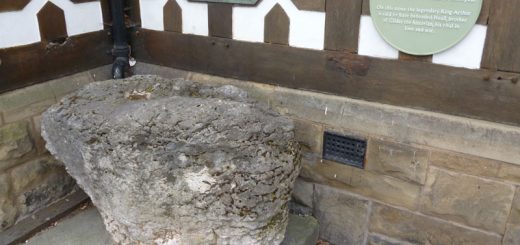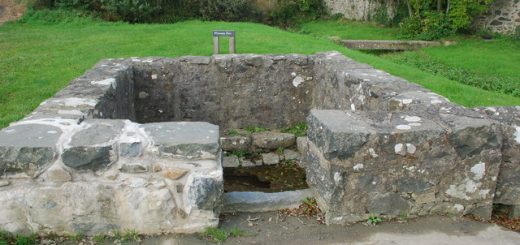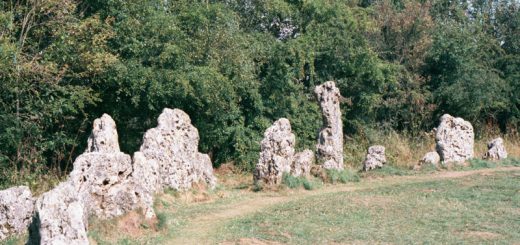St Bees Priory
The atmospheric church at St Bees is all that remains of a small Benedictine monastery closed down during the reformation. The priory is associated with the legend of St Bega, who is said to have fled here to escape an arranged marriage in Ireland. The site is also famous for discovery of a remarkably well-preserved medieval knight – the St Bees Man – who is thought to be a local lord killed in battle.
A Brief History
The origins of the church are shrouded in the legend of St Bega, which we will detail later. We do know that there was a church here during Viking times, as there are the remains of two cross shafts of Scandinavian design, typical in this part of Cumbria.

 In the early Norman period – probably after 1120 – William de Meschin founded a small monastery at the site for a Prior and 6 Benedictine monks. William was the Lord of Egremont, and one of the new (Cumbria was occupied by the Normans in the late 11th century) ruling Norman elite. The magnificent West Doorway with its grotesque weathered carving, and the Dragon Stone (opposite the West Door), which was probably a doorway lintel, date from this period.
In the early Norman period – probably after 1120 – William de Meschin founded a small monastery at the site for a Prior and 6 Benedictine monks. William was the Lord of Egremont, and one of the new (Cumbria was occupied by the Normans in the late 11th century) ruling Norman elite. The magnificent West Doorway with its grotesque weathered carving, and the Dragon Stone (opposite the West Door), which was probably a doorway lintel, date from this period.
The Priory survived right up until 1538, and the dissolution of the monasteries by Henry the VIII. The lead from the roof of the priory was removed by Henry’s men and the Priory fell into ruination. The elements ravaged the ruins until 1611, when repairs were started (although the remains had still been used for worship). William Butterfield was responsible for the next evolution of the present church, replacing the roof in 1855, and reconstructing the Chancel and aisles from 1867 – 99.
The Preserved Knight
During excavations of the former Chancel of the priory in 1981, a curious discovery was made in what was the middle of the aisle, in front of where the altar would have originally stood. Archaeologists came upon a vault, in which was the skeleton of a female, and what appeared to be a lead coffin. As part of a three-year investigation in which a number of skeletons had been excavated, it was assumed that the contents of the lead coffin would be decayed in a similar manner. The archaeologists were astounded to discover that within the lead wrapper was a complete body, enclosed in a parcel of bees wax treated cloth. The body was removed to a local hospital morgue while funds were raised to examine it properly.
 The services of Deirdre O’ Sulivan (lecturer of Archaeology) and Dr. Eddie Tapp (a paleopathologist) were acquired, and the body underwent a thorough autopsy. The preservation of the body was remarkable, much of the soft tissue appeared as though the corpse had been recently deceased, although the body was at least 500 years old. The cause of death was ascertained as a collapsed lung due to a chest injury, allowing blood and air to fill the chest cavity restricting the expansion of the lung. There were even traces of liquid blood within the wound.
The services of Deirdre O’ Sulivan (lecturer of Archaeology) and Dr. Eddie Tapp (a paleopathologist) were acquired, and the body underwent a thorough autopsy. The preservation of the body was remarkable, much of the soft tissue appeared as though the corpse had been recently deceased, although the body was at least 500 years old. The cause of death was ascertained as a collapsed lung due to a chest injury, allowing blood and air to fill the chest cavity restricting the expansion of the lung. There were even traces of liquid blood within the wound.
Just who this man was is a mystery, he was obviously a figure of some importance in the local area. It is suggested that he is Anthony De Lucy, who is thought to have died fighting abroad in 1368. In truth he may belong to anyone of the powerful families of this part of Cumbria, and his real identity may never be known. Whoever it is, it seems he died a violent death, but was obviously thought worthy of such special interment.
His body was re-intered within the chancel aisle. More information about the St Bees Man can be found at the Museum in nearby Whitehaven.
 Legends and Traditions
Legends and Traditions
In legend the Priory was founded by the shadowy figure of Bega, who is said to have originally fled Ireland in the 9th century, to escape marriage that had been arranged between her and a Norwegian king. When she arrived the lord of the land (in some versions Lord Egremont) granted that she would be able to claim all of the land that were under snow on the next day, which happened to be Midsummer’s Eve. The next day the Lord was regretting his word, as miraculously three miles of the surrounding landscape were indeed snow covered, and the Lord had to keep to his pact. There probably was a Bega, although the truth of her origins, and the history of the early Christian settlement on the site is now shrouded in the mists of time.
The church has the remains of many well-carved grave slabs dating from the Middle Ages, denoting ornate crosses, knights and men at arms, including and unusual slab depicting an archer. It has been suggested that some of these grave slabs may have been Templar in origin. This is always a possibility due to their extensive influence, although there is a danger of seeing a Knights Templar link in every ancient carved grave slab.
The church is very atmospheric and well worth a visit, to me it has an air of calm serenity I have only experienced at a few other ancient churches.
Directions: On the B5345 off the A595 to the West of Egremont.




Recent Comments